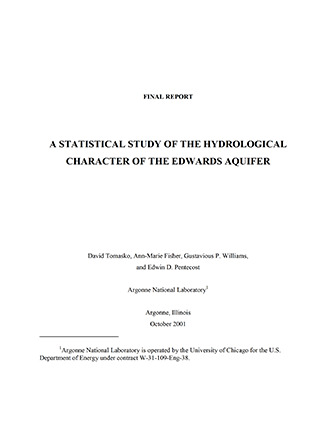|
The purpose of this study was to evaluate Edwards Aquifer–related hydrologic data from the October 1998 storm event. Surface water and groundwater levels were statistically analyzed to evaluate responses of the aquifer to the major recharge event. The study was completed in November 2001 by Argonne National Laboratory, Argonne, Illinois.
An analysis was performed on data from the October 1998 precipitation in the area of the Edwards Aquifer. Lag times and cross-correlation coefficients were found for the independent variables, including spring flow and water levels in monitor wells. Conclusions derived from the measured data include the following:
- Most of the precipitation from the October 1998 event fell on the eastern portion of the Edwards Aquifer area. This finding is consistent with published information from the USGS.
- Response of river and stream flow to the precipitation event were very rapid and produced sharp peaks in flow with fast recession curves. Because hourly data were not available for the rivers or streams, the storm surge could not be tracked downstream.
- Responses of flows from San Marcos and Comal Springs were rapid, indicating a strong connection with surface water. Peak flows were achieved at San Marcos and Comal Springs in 9 and 11 days, respectively. Because hourly data were not available, the peak could not be further delineated. The more rapid rise to peak flow in San Marcos Springs is indicative of a smaller watershed or a higher transmissivity aquifer.
- Flows in San Marcos and Comal Springs returned to their pre-event values after 166 and 220 days, respectively. The longer recession at Comal Springs may be caused by a larger watershed, a lower transmissivity, or a combination of both.
- The recession curve for flow from San Marcos Springs has a pronounced flat period that starts about 20 days after the rainfall event and lasts about 35 days. The slope of the recession curve is about the same for earlier and later times. This behavior may indicate that there is a substantial storage in the Edwards Aquifer at a depth less than that of peak conditions, or that flow may be arriving from outside its watershed. For the latter case, the travel time is about 20 days.
- Cross-correlation between flows from San Marcos and Comal Springs was very good. Filtering the field data with a moving average window did not significantly improve the results. Similarly, significant improvements were not produced by taking a log transformation of the field data. Maximum cross-correlations were obtained for a zero-day lag time. This finding is consistent with a conceptual model in which there is strong communication with surface water (rivers, streams, and runoff).
- Water levels in monitor wells in the northern portion of the Edwards Aquifer area had very high cross-correlation coefficients, as did water levels in wells in the southern portion of the area. Cross-correlations, however, between water levels in wells in the northern and southern portions of the aquifer were, in general, low.
This finding is consistent with the wells’ being completed similarly in the recharge and fresh-water zones, and, as with all statistical correlations, the results may be fortuitous.
- A four-parameter linear regression model demonstrated that inclusion of time series data from the Blanco River was not warranted because of its very high and rapid runoff response to the precipitation event.
- The best overall four-parameter model included flow from Comal Springs and water levels in monitor wells J-17 and Quihi.
- More complex models that include more than four estimated parameters could be constructed, but the inclusion of additional parameters is questionable.
- Results of the model may not be applicable for analysis of other, lower flows because the linear regression model was developed for flood conditions.
|

